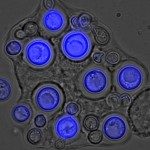Link to Pubmed [PMID] – 16299290
Infect. Immun. 2005 Dec;73(12):7977-87
Ambient pH signaling involves a cascade of conserved Rim or Pal products in ascomycetous yeasts or filamentous fungi, respectively. Recent evidences in the fungi Aspergillus nidulans, Saccharomyces cerevisiae, Yarrowia lipolytica, and Candida albicans suggested that components of endosomal sorting complexes required for transport (ESCRT) involved in endocytic trafficking were needed for signal transduction along the Rim pathway. In this study, we confirm these findings with C. albicans and show that Vps28p (ESCRT-I) and Vps32p/Snf7p (ESCRT-III) are required for the transcriptional regulation of known targets of the Rim pathway, such as the PHR1 and PHR2 genes encoding cell surface proteins, which are expressed at alkaline and acidic pH, respectively. We additionally show that deletion of these two VPS genes, particularly VPS32, has a more drastic effect than a RIM101 deletion on growth at alkaline pH and that this effect is only partially suppressed by expression of a constitutively active form of Rim101p. Finally, in an in vivo mouse model, both vps null mutants were significantly less virulent than a rim101 mutant, suggesting that VPS28 and VPS32 gene products affect virulence both through Rim-dependent and Rim-independent pathways.
